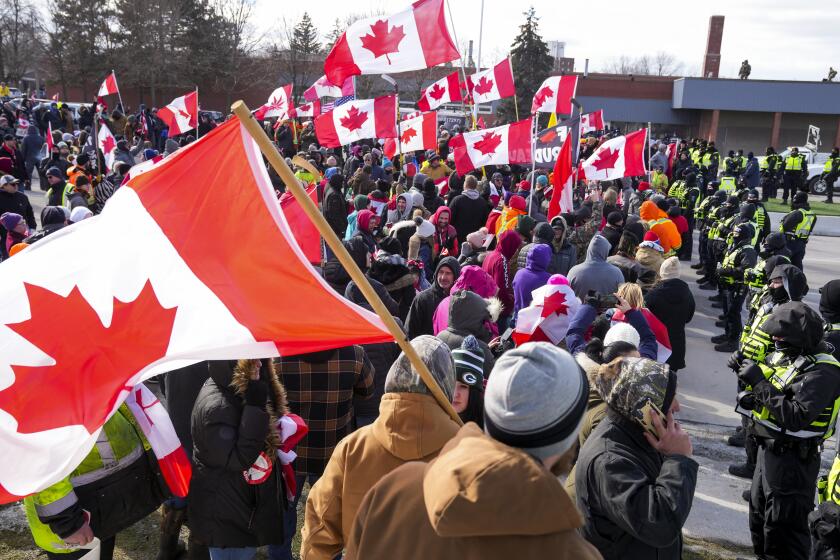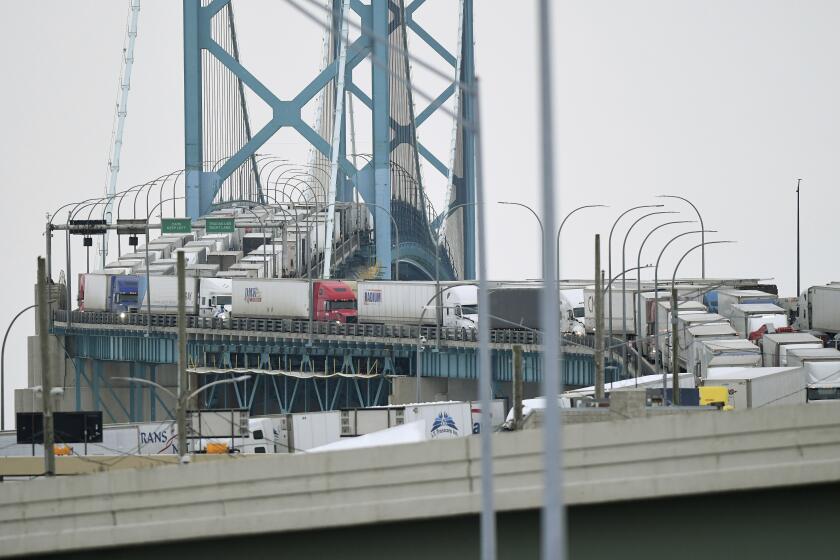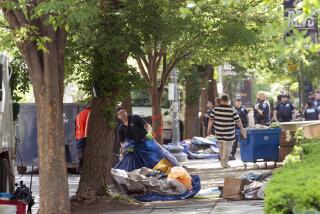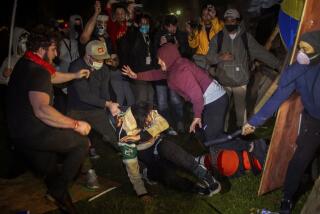Canadian police arrest protesters who remained at U.S. border
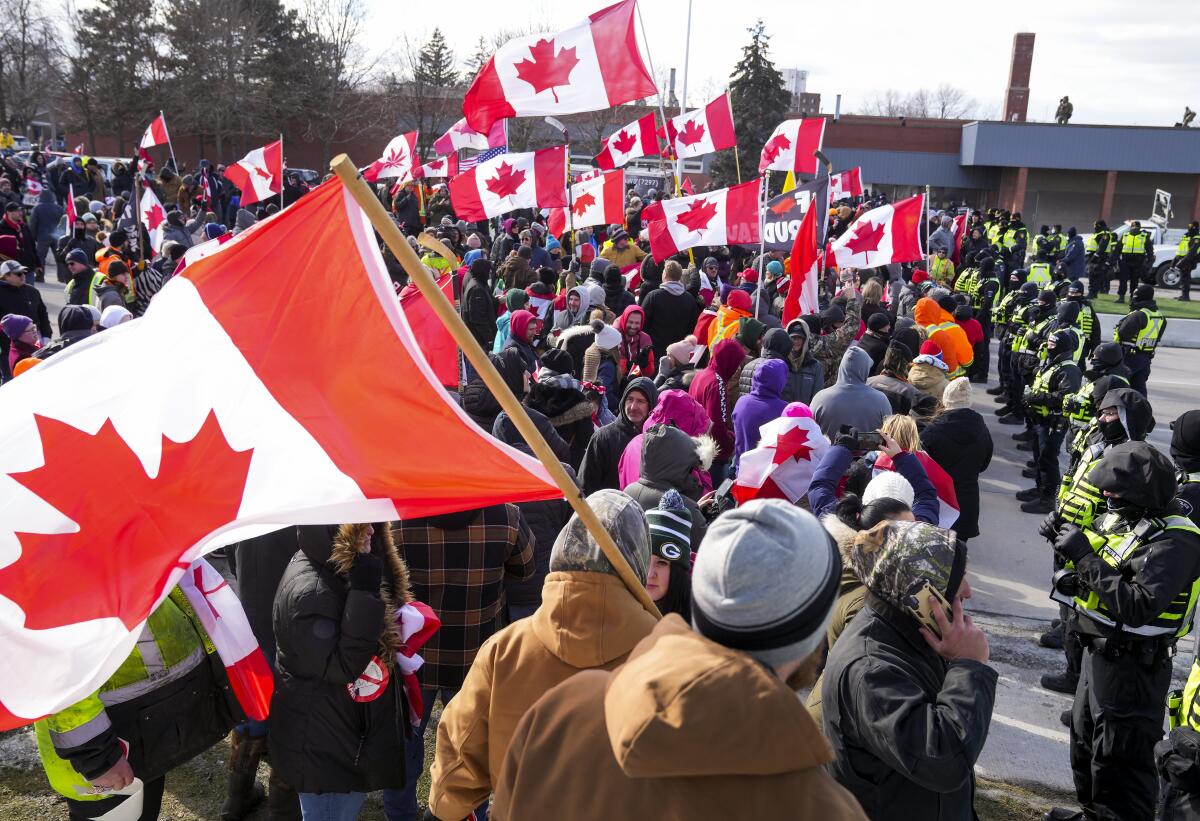
- Share via
WINDSOR, Canada — Police moved in to clear and arrest the remaining protesters near the busiest U.S.-Canadian border crossing Sunday, ending a demonstration against COVID-19 restrictions that has hurt the economy of both nations even as they held back from a crackdown on a larger protest in the capital, Ottawa.
The protest in Ottawa has paralyzed downtown, infuriated residents who are fed up with police inaction and turned up pressure on Prime Minister Justin Trudeau.
The demonstrations have reverberated across Canada and beyond, with similar convoys in France, New Zealand and the Netherlands. The U.S. Department of Homeland Security warned that truck convoys may be in the works in the United States.
Windsor police said about 25 to 30 people were peacefully arrested and seven vehicles were towed just after dawn near the Ambassador Bridge that links their city — and numerous Canadian automotive plants — with Detroit.
“Today, our national economic crisis at the Ambassador Bridge came to an end,” said Windsor’s Mayor Drew Dilkens. “Border crossings will reopen when it is safe to do so and I defer to police and border agencies to make that determination.”
But the bridge remained closed as a snowstorm hit the area, and Windsor Police Chief Pamela Mizuno didn’t offer a timetable for its reopening.
“There are steps we need to take in order to reopen the roadways so that we don’t encounter the same issue,” she said at a news conference. “We need to ensure we are able to maintain the traffic flow.”
Ottawa has become the center of a global populist backlash against vaccine mandates and, more broadly, liberal governments.
Only a few protesters had remained after police on Saturday persuaded demonstrators to move the pickup trucks and cars they had used to block a crossing that sees 25% of all trade between the two countries.
President Biden’s administration on Sunday acknowledged the seemingly peaceful resolution to the demonstration, which it said had “widespread damaging impacts” on the “lives and livelihoods of people” on both sides of the border.
“We stand ready to support our Canadian partners wherever useful in order to ensure the restoration of the normal free flow of commerce can resume,” Homeland Security advisor Liz Sherwood-Randall said in a statement.
In Ottawa, Mayor Jim Watson said Sunday that the city struck a deal with protesters who have jammed downtown streets for more than two weeks that will see them move out of residential areas in the next 24 hours.
Watson said he agreed to meet with demonstrators if they confine their protest to an area around Parliament Hill and move their trucks and other vehicles out of residential neighborhoods by noon Monday. A response from protest organizers suggested they would comply.
Watson added that residents are “exhausted″ and “on edge” because of the demonstrations and warned that some businesses were teetering on the brink of permanent closure because of the disruptions.
The ranks of protesters had swelled to what police said were 4,000 demonstrators by Saturday. A counter-protest of frustrated Ottawa residents attempted to block the convoy of trucks from entering the downtown area Sunday.
Clayton Goodwin, a 45-year-old military veteran who was among the counter-protesters, said it was time for residents to stand up against the protesters.
“I’m horrified that other veterans would be down there co-opting my flag, co-opting my service,” said Goodwin, who is the CEO of the Veterans Accountability Commission, a nonprofit advocacy group. “It’s a grift. The city was free. We’re 92% vaccinated. We’re ready to support our businesses.”
Colleen Sinclair, another counter-protester, said the demonstrators have had enough time to have their discontent heard and need to move on — with police force, if it comes down to it.
“They’re occupiers. People are scared to go to work, too scared to leave their homes,” she said. “This is not how you get your voice heard. This is domestic terrorism and we want you out of our city. Go home.”
The city has seen similar expansions of the protest on past weekends, and loud music played as people milled about downtown where anti-vaccine demonstrators have been encamped since late January, to the frustration of residents.
“It just feels like I’m living in a different country, like I’m in the States,” said Shannon Thomas, a 32-year-old teacher. “It just makes me really sad to see all these people waving Canadian flags and acting like patriots when it’s really the most sad and embarrassing thing I’ve ever seen.”
Trudeau has so far rejected calls to use the military, but had said that “all options are on the table” to end the protests. Trudeau has called the protesters a “fringe” of Canadian society. Both federal and provincial politicians have said they can’t order police what to do.
Maj.-Gen. Steve Boivin, commander of Canadian Special Operations Forces Command, said Sunday that two of his special forces soldiers were supporting the protests in Ottawa and were in the “process of being released” from service. Boivin said the activity goes against the military’s values and ethics.
On Friday, a judge ordered an end to the blockade at the crossing in Windsor, and Ontario Premier Doug Ford declared a state of emergency allowing for fines of 100,000 Canadian dollars and up to one year in jail for anyone illegally blocking roads, bridges, walkways and other critical infrastructure.
Partial closures at the bridge started on Feb. 7 and by midweek the disruption was so severe that automakers began shutting down or reducing production. The standoff came at a time when the industry is already struggling to maintain production in the face of pandemic-induced shortages of computer chips and other supply-chain disruptions.
“We are protesting the government taking away our rights,” said Windsor resident Eunice Lucas-Logan. “We want the restrictions removed.”
The 67-year-old has been out supporting the protest for the last four days. She said she appreciated that police have been patient.
On the other side of the country, a major truck border crossing between Surrey and Blaine, Wash., was closed Sunday, a day after Canadian authorities said a few vehicles had breached police barricades and a crowd entered the area by foot.
The Royal Canadian Mounted Police said Sunday afternoon that four people had been arrested for “mischief” during the protest. Some people who stayed overnight had packed up and left, but the border crossing and roads in the area remained closed.
A border blockade that began in Coutts, Alberta, north of Sweet Grass, Mont., on Jan. 29 remained in place as well. Police issued more than 50 traffic tickets Saturday and continued issuing them Sunday, RCMP Cpl. Troy Savinkoff said.
Officers also intercepted and disabled three excavators that were being brought to the protest, Savinkoff said.
Posts are springing up across the web about a U.S. truck protest in California. Law enforcement sources say they are aware, but it is mostly aspirational in nature so far.
Pandemic restrictions have been far stricter there than in the U.S., but Canadians have largely supported them. The vast majority of Canadians are vaccinated, and the COVID-19 death rate is one-third that of the United States.
More to Read
Sign up for Essential California
The most important California stories and recommendations in your inbox every morning.
You may occasionally receive promotional content from the Los Angeles Times.
